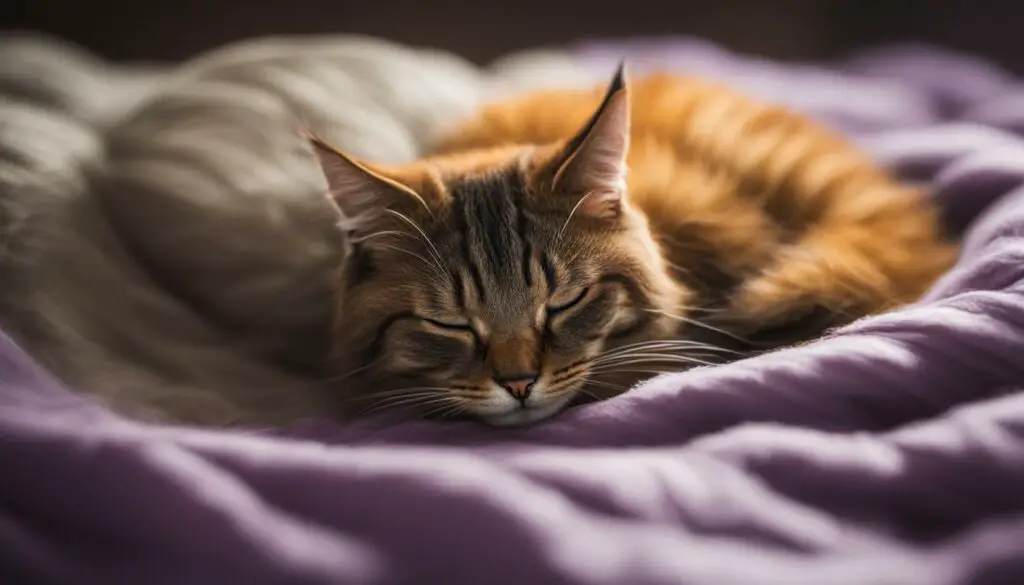If you’re wondering why your cat is sleepy after flea treatment, it’s important to understand the effects of the treatment on your cat’s behavior. Flea treatments, especially those in liquid form known as spot-on treatments, can take up to 30-45 minutes to dry on your cat’s fur. During this time, it’s recommended to avoid touching or stroking the area to ensure the treatment is fully absorbed. Spot-on flea treatments work by translocation, meaning the treatment moves around your cat’s body. This process can take up to 24 hours to kill all active fleas on your cat. It’s normal for the area where the treatment was applied to be greasy, but this should subside after 48 hours. It’s important to follow the recommended application and wait time for each specific brand of flea treatment to ensure its effectiveness and reduce any potential side effects.
Key Takeaways:
- Cat may feel sleepy after flea treatment due to the medication’s effect on their behavior.
- Spot-on treatments take time to dry and be fully absorbed into the cat’s body.
- The treatment works by translocating throughout the cat’s body to kill fleas.
- Greasiness at the application site is normal and should subside after 48 hours.
- Follow the recommended application and wait time to ensure effectiveness and minimize side effects.
How Long Does It Take for Flea Medicine to Work on Cats?
When it comes to treating fleas in cats, one common question is how long it takes for flea medicine to work. The answer depends on the specific brand and type of flea treatment you are using. After applying the treatment, fleas or ticks that come into direct contact with it will typically die shortly after. However, it may take up to 24 hours for the treatment to fully eliminate all active fleas, eggs, and larvae on your cat. It’s important to note that flea treatments typically last for a cycle of 30 days, so it’s recommended to follow the instructions on the packaging regarding reapplication.
If you notice any lingering fleas on your cat after the recommended time has passed, it may be necessary to consult with your veterinarian for further advice. They can provide guidance on whether a different treatment option is needed or if there may be other factors contributing to the flea infestation.
Overall, it’s important to be patient when using flea medicine on your cat. It may take some time for the treatment to completely eliminate the fleas, but with consistent use and proper application, you can help protect your cat from these pesky parasites.
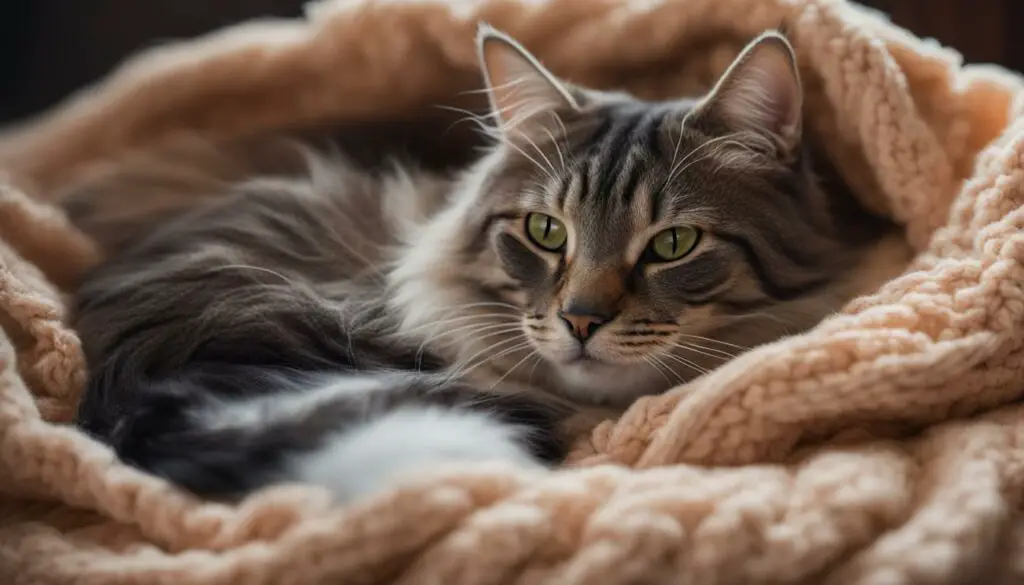
Table: Comparison of Popular Flea Medicines for Cats
| Brand | Type of Treatment | Time to Kill Fleas | Duration of Effectiveness |
|---|---|---|---|
| Brand A | Spot-on | 24 hours | 30 days |
| Brand B | Oral | 12 hours | 30 days |
| Brand C | Collar | 48 hours | 8 months |
Note: The time to kill fleas and duration of effectiveness may vary based on factors such as the severity of the infestation and individual cat’s response to the treatment. It’s important to consult with your veterinarian to determine the best flea medicine for your cat’s specific needs.
Why Does My Cat Have Greasy Fur After Flea Treatment?
After applying flea treatment to your cat, you may notice that their fur becomes greasy in the area where the treatment was applied. So why does this happen? It’s actually a normal reaction to the flea treatment. Most flea treatments, especially spot-on treatments in liquid form, contain carrier oils that help the treatment spread throughout your cat’s coat. These oils can leave the fur looking greasy, but don’t worry, it’s temporary.
The greasiness should start to subside after about 48 hours as the chemicals in the flea treatment are absorbed into your cat’s body. During this time, it’s important to avoid touching or cleaning the greasy area to ensure that the treatment is fully absorbed and effective. It’s also worth noting that different brands of flea treatments may have varying levels of greasiness, so the severity and duration of the greasiness can differ.
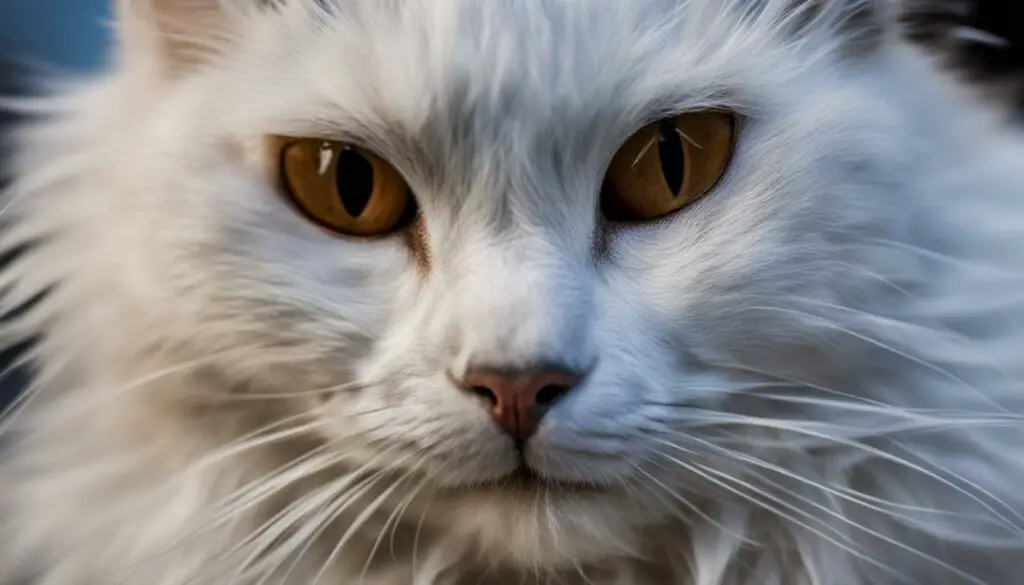
If you have any concerns about your cat’s fur appearance or if the greasiness persists beyond the expected timeframe, it’s always a good idea to consult with your veterinarian. They can provide further guidance and address any questions or worries you may have about your cat’s post-flea treatment behavior and appearance.
Can Steroid Shots Make Cats Sleepy?
Yes, steroid shots can make cats sleepy. Steroids have a sedative effect on cats, which can cause drowsiness and lethargy. This is a common side effect of the medication and is generally not harmful to cats. However, if you have concerns about your cat’s sleepiness after a steroid shot, it’s advised to consult with your veterinarian for further evaluation and advice.
It’s important to note that the sleepiness experienced by cats after a steroid shot is temporary and typically subsides within a few hours to a couple of days. Cats may also exhibit increased thirst and appetite as a result of the medication. These side effects are usually mild and transient.
“While steroids can make cats sleepy, it is important to monitor their overall behavior and health during the treatment period,” says Dr. Sarah Thompson, a veterinarian with over 10 years of experience. “If you notice any concerning changes in your cat’s behavior or if they seem excessively lethargic, it’s best to contact your veterinarian for guidance.”
When administering steroid shots to cats, veterinarians carefully consider the appropriate dosage based on the cat’s weight and specific condition. It’s crucial to follow the prescribed treatment plan and not self-administer steroids to your cat without professional guidance. Steroids are powerful medications that can have significant effects on a cat’s health, so it’s always best to consult with a veterinarian to ensure the safety and well-being of your feline companion.
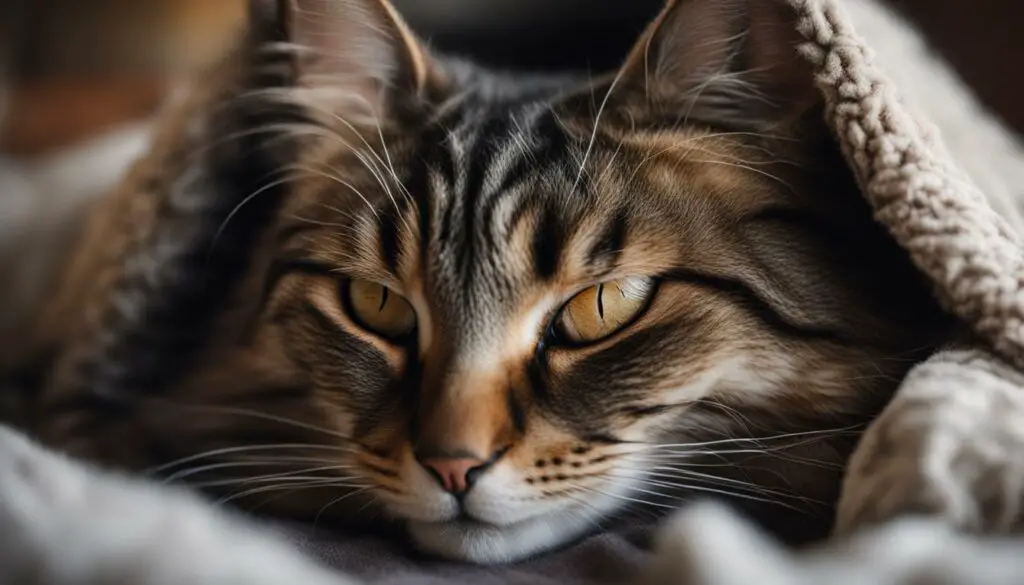
| Side Effects of Steroid Shots in Cats | Possible Symptoms |
|---|---|
| Increased thirst | Excessive drinking or seeking water sources |
| Increased appetite | Excessive hunger or food begging |
| Sleepiness and lethargy | Reduced activity levels and prolonged periods of sleep |
| Changes in behavior | Altered mood, unusual aggression, or excessive grooming |
| Suppressed immune system | Increased vulnerability to infections |
How Long Do Steroids Take to Work on Cats?
When it comes to using steroids in cat treatment, one common question pet owners have is how long it takes for the steroids to work on their furry friends. The duration of steroids’ effectiveness can vary based on the specific medication and the cat’s individual response.
In general, corticosteroids like prednisolone can start to show improvement within a day or two of starting the treatment. These medications work by suppressing the cat’s immune system and reducing inflammation, which can help alleviate symptoms associated with various health conditions.
However, it’s important to note that the timeline for the steroids to take effect may be longer for more complex conditions or if the cat’s immune system is compromised. It’s crucial to follow the prescribed treatment plan and consult with your veterinarian for any concerns or questions regarding the effectiveness of the steroids.
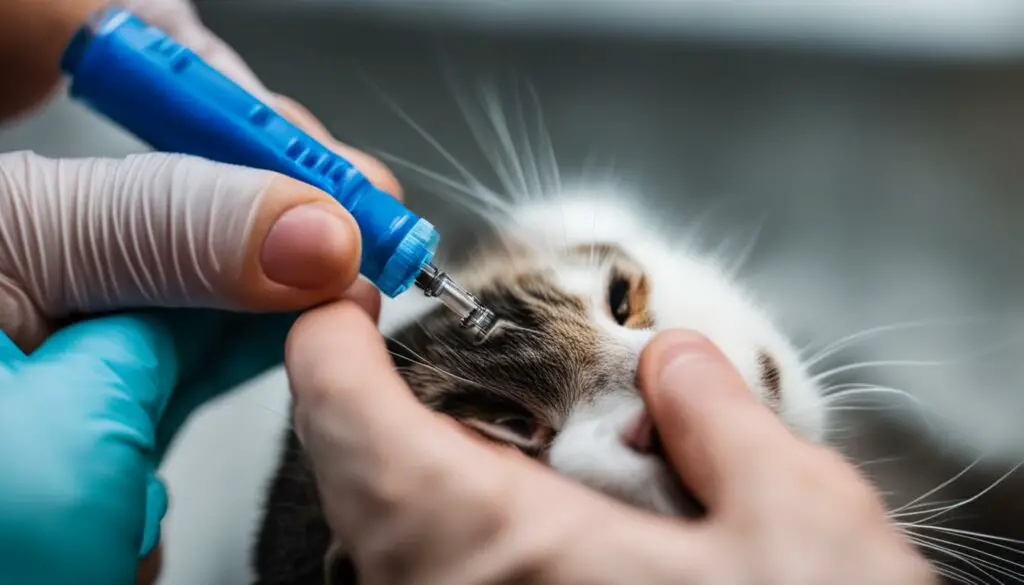
Table: Comparison of Steroid Medications for Cats
| Medication | Duration of Effectiveness | Common Uses |
|---|---|---|
| Prednisolone | Varies depending on the cat’s response | Allergic reactions, inflammatory disorders, autoimmune diseases |
| Dexamethasone | 1-2 days | Allergic reactions, inflammatory disorders, certain cancers |
| Methylprednisolone | Up to 72 hours | Inflammatory conditions, spinal cord injuries |
It’s important to remember that steroids are powerful medications with potential side effects. Long-term use or excessive doses can lead to adverse effects like increased thirst and appetite, weight gain, and increased susceptibility to infections. Therefore, it’s crucial to work closely with your veterinarian to develop an appropriate treatment plan and monitor your cat’s response to the medication.
Overall, the effectiveness of steroids in cats can vary, and it’s essential to have realistic expectations while closely following the prescribed treatment plan. With proper monitoring and guidance from your veterinarian, steroids can be a valuable tool in managing various health conditions and improving your cat’s quality of life.
Can Steroids Make Cats Aggressive?
There is ongoing debate about whether steroids can make cats aggressive. While some anecdotal evidence suggests a possible link between steroid use and changes in cat behavior, there is no scientific consensus or concrete evidence to support the claim that steroids directly cause aggression in cats. It’s important to note that aggression in cats can have various causes, including fear, stress, territoriality, or underlying medical conditions. Therefore, it’s essential to consider other factors before attributing aggression solely to steroid use.
When cats are prescribed steroids for medical reasons, such as to manage inflammatory conditions or immune system disorders, changes in behavior may occur as a side effect. These changes can range from increased appetite and thirst to mood alterations. However, aggressive behavior is not commonly reported as a direct side effect of steroid use in cats. If you do observe aggressive behavior in your cat after starting steroid treatment, it’s crucial to consult with your veterinarian to rule out other underlying causes and explore appropriate management strategies.
When it comes to managing aggression in cats, a comprehensive approach is necessary. This may involve behavioral modification techniques, environmental enrichment, stress reduction strategies, and in some cases, medication or hormone therapy. It’s vital to work closely with your veterinarian to identify the root cause of aggression and develop an individualized treatment plan tailored to your cat’s specific needs.
Remember, every cat is unique, and their response to medication can vary. What works for one cat may not work for another. By working closely with your veterinarian and using positive reinforcement techniques, you can help create a safe and harmonious environment for your cat, promoting their well-being and reducing the likelihood of aggressive behavior.
| Myth: | Reality: |
|---|---|
| Steroids directly cause aggression in cats. | There is no scientific evidence to support this claim. |
| Steroids are the sole cause of behavior changes in cats. | Behavior changes can have various causes, and steroids are just one possible factor. |
| All cats on steroids will become aggressive. | Behavioral changes can vary between individual cats, and not all will experience aggression. |
Understanding Normal Shedding vs. Unhealthy Hair Loss in Cats
Shedding is a natural process for cats as they continuously grow and replace their fur. However, it’s important for cat owners to differentiate between normal shedding and unhealthy hair loss. Normal shedding typically occurs seasonally, with cats shedding more during the spring and fall. During this time, you may notice an increase in hair around your home, on your furniture, and on your clothes. This shedding should be even across the body and should not result in bald spots or patchiness.
On the other hand, unhealthy hair loss may be accompanied by a variety of signs. These signs can include uneven shedding, bald spots, changes in skin condition, increased scratching, and alterations in grooming behavior. If you notice any of these symptoms, it’s important to consult with your veterinarian to determine the underlying cause and appropriate treatment.
Table:
| Normal Shedding | Unhealthy Hair Loss |
|---|---|
| Even shedding | Uneven shedding |
| No bald spots or patchiness | Bald spots or patchiness |
| Seasonal shedding | Excessive shedding throughout the year |
| No changes in skin condition | Changes in skin condition |
| No increased scratching | Increased scratching |
| No alterations in grooming behavior | Altered grooming behavior |
If you notice signs of unhealthy hair loss in your cat, it’s important to take action to address the underlying cause. This may involve changes in diet, grooming practices, or the use of specific treatments for allergies, parasites, or other health conditions. Your veterinarian can provide guidance and develop a personalized plan for promoting healthy hair growth in your cat.
Stress-Induced Fur Loss in Cats
Stress can have a significant impact on a cat’s overall well-being and can even result in fur loss. When cats experience stress, their bodies release hormones that can affect their skin and hair follicles, leading to excessive grooming and fur loss. It’s important to recognize the signs of stress in cats and take steps to manage and reduce it.
Managing stress in cats involves creating a safe and calm environment for them. This can include providing hiding spots or cozy spaces where they can retreat when feeling overwhelmed. Maintaining a consistent routine and minimizing changes in their daily lives can also help reduce stress levels. Additionally, interactive toys and regular playtime can provide mental stimulation and help cats release any pent-up tension.
If your cat is experiencing stress-induced fur loss, it’s essential to consult with your veterinarian. They can assess your cat’s overall health and help identify the underlying causes of stress. In some cases, medication or supplements may be recommended to help reduce anxiety. Your veterinarian may also provide behavioral modification techniques or refer you to a professional behaviorist to address any specific stress triggers.
| Signs of Stress in Cats | Management Strategies |
|---|---|
|
|
|
|
“Stress can have a profound impact on a cat’s well-being, and it’s important to address it promptly. By creating a calm and safe environment, providing mental stimulation, and seeking professional guidance when needed, we can help our feline friends lead happier and healthier lives.”
Allergies and Fur Loss in Cats
Allergies can be a common cause of fur loss in cats. Just like humans, cats can develop allergies to various substances such as pollen, mold, dust mites, or certain foods. When a cat is allergic to something, it can manifest in different ways, including excessive scratching, chewing on the skin, and hair loss. Some cats may also develop skin rashes or sores.
To manage cat allergies and reduce fur loss, it is important to identify the specific allergen through allergy testing. Once the allergen is identified, steps can be taken to minimize the cat’s exposure to it. This may include keeping the cat indoors during high pollen seasons, using air purifiers to reduce dust and allergens in the home, and providing a hypoallergenic diet.
Medications, such as antihistamines or corticosteroids, may also be prescribed by a veterinarian to help alleviate allergy symptoms and reduce fur loss. Regular grooming can also help remove allergens from the cat’s fur and skin, promoting a healthier coat. It’s important to consult with a veterinarian for proper diagnosis and guidance on managing cat allergies and fur loss.
Common Cat Allergy Symptoms:
- Skin redness or inflammation
- Excessive scratching or licking
- Hair loss or thinning
- Skin lesions or sores
- Sneezing or coughing
- Watery or itchy eyes
- Vomiting or diarrhea
“Allergies can be a common cause of fur loss in cats. It’s important to identify the specific allergen and take steps to minimize the cat’s exposure to it.”
By managing cat allergies and addressing the underlying cause of fur loss, it is possible to help cats maintain a healthy and lustrous coat. Regular veterinary check-ups and open communication with your veterinarian are crucial in developing an effective allergy management plan for your cat.
Table: Common Cat Allergy Triggers
| Allergen | Symptoms |
|---|---|
| Pollen | Sneezing, coughing, itchy eyes, hair loss |
| Dust Mites | Itchy skin, hair loss, sneezing, respiratory issues |
| Mold | Itchy skin, hair loss, sneezing, respiratory issues |
| Flea Bites | Intense itching, hair loss, skin sores or lesions |
| Certain Foods | Itchy skin, hair loss, gastrointestinal issues |
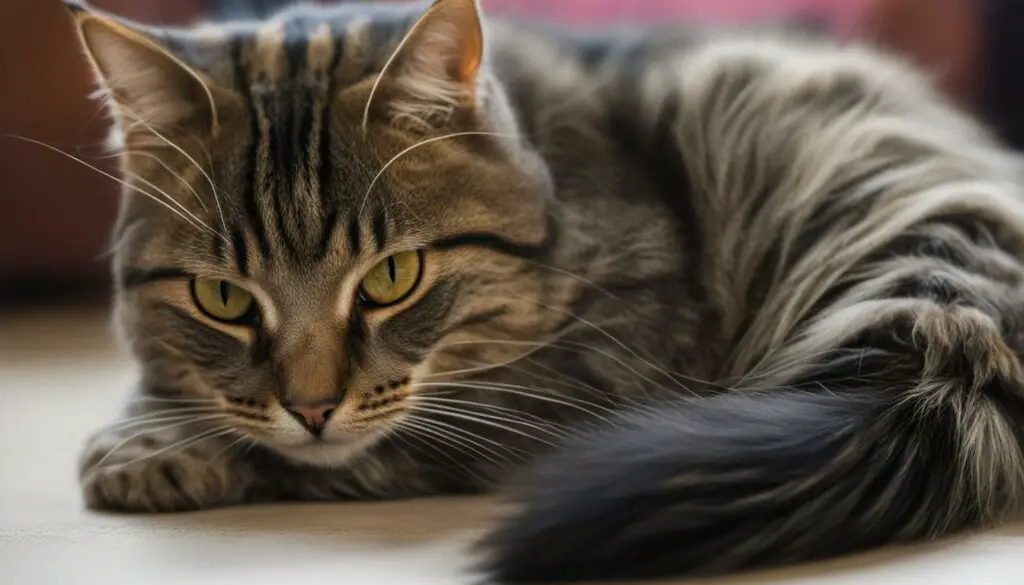
Parasites and Fur Loss in Cats
Parasites can be a common cause of fur loss in cats. Fleas, ticks, and mites can cause itching, inflammation, and hair loss as they bite and irritate your cat’s skin. To effectively treat and prevent parasites in cats, it’s important to use vet-recommended anti-parasitic products regularly. Applying these products helps eliminate existing infestations and protects against future ones.
When treating parasites in cats, it’s crucial to follow the recommended application guidelines provided by the product manufacturer. Applying the appropriate dosage and adhering to the recommended frequency of treatment ensures the effectiveness of the product and helps prevent resistance development in parasites.
Preventing parasites in cats:
- Keep your cat’s environment clean by regularly vacuuming and washing their bedding.
- Regularly groom your cat and inspect their fur for any signs of parasites.
- Avoid contact with other animals that may have parasites.
- Use flea and tick preventives recommended by your veterinarian.
Cats are natural groomers, and excessive grooming can lead to hair loss. In cases of parasite infestations, cats may excessively lick and bite their fur, resulting in bald patches. If you notice fur loss accompanied by scratching or visible signs of parasites, it’s important to consult with your veterinarian for appropriate treatment options.
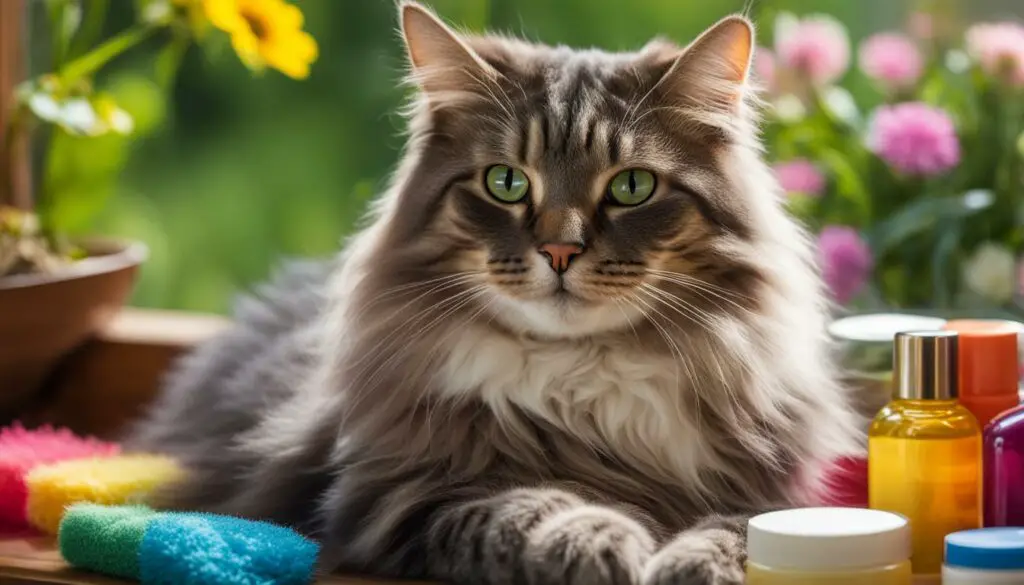
The Importance of Regular Check-ups
Regular veterinary check-ups are vital for monitoring your cat’s overall health, including the prevention and treatment of parasites. Your veterinarian can provide guidance on the most effective anti-parasitic products for your cat, based on their health status and lifestyle. They can also assist in identifying any signs of infestations or possible underlying health conditions contributing to fur loss.
By addressing and managing parasites promptly, you can minimize the discomfort and potential complications associated with infestations. Remember, prevention is key, so stay proactive in protecting your feline companion from parasites to ensure a healthy and flourishing coat.
Health Conditions and Fur Loss in Cats
When it comes to fur loss in cats, there are various health conditions that could be at play. Identifying and managing these conditions is crucial for promoting healthy fur growth and overall well-being in our feline friends. In this section, we’ll explore some common health conditions that can cause fur loss in cats and discuss strategies for managing them.
Common Health Conditions
Hyperthyroidism, ringworm, hormonal imbalances, bacterial infections, and allergies are among the health conditions that may contribute to fur loss in cats. Hyperthyroidism, a condition characterized by an overactive thyroid gland, can lead to excessive shedding and hair thinning. Ringworm, a fungal infection, can cause circular patches of hair loss and skin inflammation. Hormonal imbalances, such as those caused by reproductive issues or adrenal gland dysfunction, can also result in fur loss. Bacterial infections, particularly those affecting the skin, can cause hair loss and skin lesions. And lastly, allergies, whether to food, environmental factors, or certain substances, can trigger excessive scratching, inflammation, and fur loss in cats.
Managing Health Conditions
When it comes to managing health conditions that contribute to fur loss in cats, it’s important to consult with a veterinarian for an accurate diagnosis and appropriate treatment plan. The specific treatment options will depend on the underlying condition and may include medication, dietary changes, or other interventions. Regular veterinary check-ups are essential for monitoring the cat’s progress and adjusting the treatment plan as needed. Additionally, providing a clean and safe environment, maintaining a consistent routine, and offering interactive toys and quality time can contribute to the overall health and appearance of the cat’s fur.
| Health Condition | Signs and Symptoms | Treatment Options |
|---|---|---|
| Hyperthyroidism | Excessive shedding, hair thinning | Medication, diet, radioactive iodine therapy, surgery |
| Ringworm | Circular patches of hair loss, skin inflammation | Antifungal medication, quarantine, environmental cleaning |
| Hormonal Imbalances | Fur loss, reproductive issues | Medication, surgery, hormone therapy |
| Bacterial Infections | Hair loss, skin lesions, inflammation | Antibiotics, topical treatments, medicated shampoos |
| Allergies | Excessive scratching, inflammation, fur loss | Allergen avoidance, medication, immunotherapy |
By addressing underlying health conditions and providing proper care and attention, we can help our cats maintain healthy and lustrous coats. It’s essential to work closely with a veterinarian to ensure the best outcome for our furry companions.
Reversing Hair Loss and Promoting Healthy Fur Growth in Cats
If your cat is experiencing hair loss, it’s essential to identify the underlying cause and take appropriate steps to reverse the hair loss and promote healthy fur growth. Managing fur loss in cats involves a combination of addressing the root issue, providing proper care and nutrition, and following a consistent routine. Here are some strategies to help your cat regain a lustrous coat:
1. Consult with a Veterinarian
When you notice hair loss in your cat, it’s crucial to schedule a visit with your veterinarian. They will be able to determine the cause of the hair loss through a thorough examination and may recommend additional tests if necessary. With an accurate diagnosis, the veterinarian can recommend an appropriate treatment plan tailored to your cat’s specific needs.
2. Address Underlying Issues
Hair loss in cats can be a result of various factors, including allergies, parasites, stress, or underlying health conditions. Once the underlying cause is identified, it’s important to address it directly. This may involve implementing parasite prevention measures, managing allergies, reducing stress, or treating any health conditions. By treating the root cause, you can help promote regrowth of your cat’s fur.
3. Provide Quality Nutrition
A well-balanced diet is essential for overall health and the growth of healthy fur in cats. Ensure that your cat’s food provides all the necessary nutrients, including protein, vitamins, and minerals. Consult with your veterinarian to determine the best diet for your cat’s specific needs. Additionally, supplements such as omega-3 fatty acids can promote healthy skin and fur.
4. Grooming and Hygiene
Regular grooming can stimulate blood circulation, distribute natural oils, and remove loose fur, which can help promote healthy fur growth. Brush your cat’s coat gently with a suitable brush or comb to prevent matting and remove any debris. However, avoid excessive grooming, as it can further contribute to hair loss. Additionally, maintaining good hygiene by keeping your cat’s living environment clean can also support healthy fur growth.

By consulting with a veterinarian, addressing underlying issues, providing quality nutrition, and practicing good grooming and hygiene, you can help reverse hair loss and promote healthy fur growth in your cat. Remember, each cat is unique, and it may take time to see results. Be patient and consistent in your approach, and your cat’s fur will regain its luster.
Conclusion
In summary, cat fur loss can be caused by various factors, such as flea treatments, stress, allergies, parasites, and underlying health conditions. It’s important to closely monitor your cat’s behavior, grooming habits, and fur condition to detect any changes early on. Consulting with a veterinarian is crucial for accurate diagnosis and tailored treatment plans to address the specific needs of your cat.
By addressing the underlying causes and providing appropriate care and attention, you can help your cat maintain a healthy and lustrous coat. This may involve implementing stress reduction techniques, managing allergies or parasites, treating health conditions, and ensuring a clean and safe environment. Regular veterinary check-ups will help monitor progress and make any necessary adjustments to the treatment plan.
Remember, promoting healthy fur growth and reversing hair loss in cats requires a comprehensive approach. Following a consistent routine, providing interactive toys and quality time, and maintaining a proper grooming and dietary care regimen are essential. With proper care and attention, your cat can enjoy a beautiful and vibrant coat.
FAQ
Why is my cat sleepy after flea treatment?
Flea treatments, especially spot-on treatments, can take time to dry and be fully absorbed by your cat’s body. During this time, it’s normal for cats to feel sleepy or lethargic. Additionally, the active ingredients in flea treatments can have sedative effects on cats. If you’re concerned, monitor your cat’s behavior and contact your veterinarian if the sleepiness persists or is accompanied by other concerning symptoms.
How long does it take for flea medicine to work on cats?
It can take up to 24 hours for flea medicine to kill all active fleas, eggs, and larvae on your cat. The time may vary depending on the specific brand and type of treatment. Remember to follow the recommended application and wait time for each product to ensure its effectiveness. If you notice lingering fleas after the recommended time, consult your veterinarian for further advice.
Why does my cat have greasy fur after flea treatment?
It is normal for your cat to have a greasy patch where the flea treatment was applied. Flea treatments are often mixed with a carrier oil to help them spread throughout the fur. This greasiness should subside after 48 hours as the treatment is absorbed into your cat’s body. Avoid touching or cleaning the greasy area during this time to ensure the effectiveness of the treatment.
Can steroid shots make cats sleepy?
Yes, steroid shots can have a sedative effect on cats, causing sleepiness or lethargy. This is a common side effect and is generally not harmful. However, if you have concerns about your cat’s sleepiness after a steroid shot, it’s best to consult with your veterinarian for further evaluation and advice.
How long do steroids take to work on cats?
The duration of time it takes for steroids to work on cats can vary. Corticosteroids like prednisolone can start to show improvement within a day or two of starting the treatment. However, the timeline may be longer for more complex conditions or if the cat’s immune system is compromised. It’s important to follow the prescribed treatment plan and consult with your veterinarian for any concerns or questions regarding the effectiveness of the steroids.
Can steroids make cats aggressive?
There is no scientific evidence to support the claim that steroids make cats aggressive. While some cats may exhibit behavioral changes while on steroids, aggression is not a common side effect. However, if you notice any significant changes in your cat’s behavior after starting steroid treatment, it’s recommended to consult with your veterinarian for further evaluation and advice.
What is the difference between normal shedding and unhealthy hair loss in cats?
Normal shedding in cats occurs seasonally and should be even across the body. It is a natural part of the hair growth cycle. Unhealthy hair loss, on the other hand, may be accompanied by uneven shedding, bald spots, skin conditions, increased scratching, and changes in grooming behavior. If you notice signs of unhealthy hair loss in your cat, it’s best to consult with your veterinarian to determine the underlying cause and appropriate treatment.
Can stress cause fur loss in cats?
Yes, stress can cause fur loss in cats. Changes in the environment, such as moving to a new home or the introduction of a new pet, can trigger stress in cats. This stress can lead to excessive grooming and fur loss. It’s important to identify and address the source of stress to help your cat’s fur growth return to normal. Creating safe spaces, maintaining a consistent routine, providing interactive toys, and spending quality time with your cat can help alleviate stress in cats.
Can allergies cause fur loss in cats?
Yes, allergies can cause excessive scratching and fur loss in cats. Common allergens include pollen, flea bites, and certain foods. If your cat is experiencing fur loss due to allergies, it’s important to identify the specific allergen through allergy testing and develop an appropriate treatment plan. Regular veterinary check-ups are essential for monitoring and managing allergic reactions in cats.
Can parasites cause fur loss in cats?
Yes, parasites like fleas, ticks, and mites can cause itching, inflammation, and fur loss in cats. Regular application of vet-recommended anti-parasitic products is crucial in preventing infestations. If you notice fur loss accompanied by scratching or visible signs of parasites, it’s recommended to consult with your veterinarian for appropriate treatment options.
What health conditions can cause fur loss in cats?
Certain health conditions like hyperthyroidism, ringworm, hormonal imbalances, bacterial infections, and allergies can cause fur loss in cats. If you notice fur loss accompanied by other symptoms such as lethargy or weight loss, it’s important to seek veterinary attention for proper diagnosis and treatment.
How can I promote healthy fur growth in my cat?
Reversing hair loss and promoting healthy fur growth in cats requires identifying and addressing the underlying cause. This may involve implementing stress reduction techniques, managing allergies or parasites, treating health conditions, and providing appropriate grooming and dietary care. Regular veterinary check-ups are essential for monitoring progress and adjusting treatment plans as needed.

